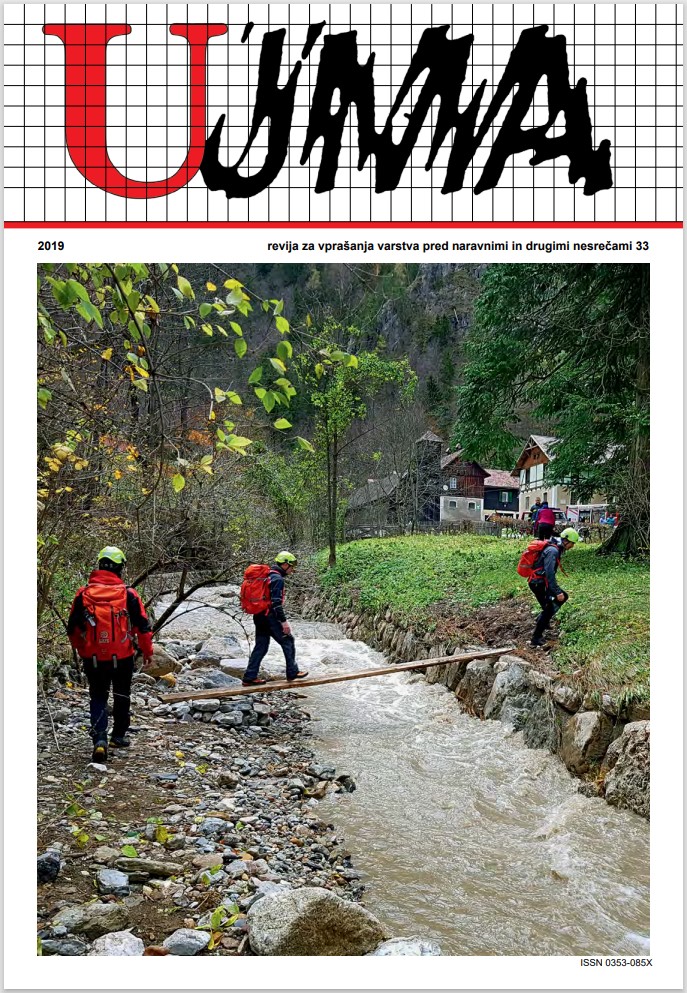FAMILIARITY WITH FIRST AID INSTRUCTIONS IN THE EVENT OF A SNAKEBITE – A SURVEY REPORT
Abstract
Three species of indigenous venomous snakes live in Slovenia: the European adder, the European asp, and the horned viper. People are at risk from their bites from early spring to late autumn during various outdoor activities. In the event of a snakebite, appropriate first aid and subsequent medical care are of crucial importance. The aim of the research presented in this article was to determine the level of first aid skills in the event of a snakebite among hikers, mountaineers, and sport climbers. An online survey questionnaire was filled out by 176 people. The majority of respondents knew which snake species are venomous in Slovenia; however, their identification of snakes in photos was poor, with the horned viper being recognized most frequently. The responders were familiar with individual first aid actions in the event of a venomous snakebite; nevertheless, two-thirds of them would bandage the affected limb, which is inappropriate. First aid training for hikers, mountaineers, and sport climbers should emphasize the harm in bandaging the wounded limb while administering first aid after a snakebite, and focus on preventive measures to minimize the risk of venomous snakebites.
References
Alberts, M. B., Shalit, M., LoGalbo, F., 2004. Suction for venomus snakebite. Ann Emerg Med. 43 (2): 181–186.
Avau, B., Borra, V., Vandekerchove, P., De Buck, E., 2016. The Treatment of Snake Bites in a First Aid Setting: A Systematic Review. PLoS Negl Trop Dis; 10(10).
Brvar, M., 2006. Zastrupitve. V: Ahčan, U., ur. Prva pomoč: priročnik s praktičnimi primeri. 1. izd. Ljubljana: Rdeči križ Slovenije, 153–75.
Brvar, M., 2018. Prva pomoč pri ugrizu gada ali modrasa: http://ktf.si/opozorila/prva-pomoc-pri-ugrizu-gada-ali-modrasa/ (20. 1. 2018).
Boyd, J. J., Agazzi, G., Svajda, D., J Morgan, A., Ferrandis, S., L Norris, R., 2007. Venomous Snakebite in Mountainous Terrain: Prevention and Management. Wilderness & environmental medicine. 18. 190–202.
Bush, S. P., 2004. Snakebite Suction Devices Don’t Remove Venom: They Just Suck. Ann Emerg Med. 43: 187–8.
Casewell, N. R., Al-Abdulla, I., Smith, D., Coxon, R., Landon, J., 2014. Immunological cross-reactivity and neutralisation of European viper venoms with the monospecific vipera berus antivenom Vipera Tab. Toxins 6(8), 2471–82.
Chen, C., Gui, L., Kan, T., Li, S., & Qiu, C., 2016. A Survey of Snakebite Knowledge among Field Forces in China. International journal of environmental research and public health, 14(1), 15.
Čerpnjak, D., Küronja, M., 2016. Prikaz primerov bolnikov po ugrizu modrasa in vzhodne diamantne klopotače. V: Vajd, R., Gričar, M. ur. Urgentna medicina, izbrana poglavja. Zbornik; 23. Mednarodni simpozij o urgentni medicini. Portorož: 9.–11. junij 2016, 294–7.
Dornik, S., Fink, R., Slabe, D., 2013. Uporaba alkohola v prvi pomoči nekoč in danes: http://www.sos112.si/slo/tdocs/ujma/2013/255.pdf (15. 7. 2018).
Fon, D., 2015. Učinek pedagoških delavcev v Živalskem vrtu Ljubljana na stališča in znanje osnovnošolcev o kačah. Diplomsko delo. Ljubljana: Univerza v Ljubljani.
Gorska Reševalna zveza Slovenije, 2019. Statistika nesreč: https://www.grzs.si/statistika_nesrec.php (10. april 2019).
Grenc, D., 2015. Ugrizi strupenih kač. V: Brvar, M. ur. Toksikologija 2015: piki in ugrizi strupenih živali: zbornik prispevkov. Slovensko zdravniško društvo, Sekcija za klinično toksikologijo: Univerzitetni klinični center, Center za zastrupitve, Interna klinika. Ljubljana 10. april 2015, 15–8.
Kasturiratne, A., Wickremasinghe, A. R., de Silva, N., Gunawardena, N. K., Pathmeswaran, A., Premaratna, R., de Silva, H. J., 2008. The global burden of snakebite: a literature analysis and modelling based on regional estimates of envenoming and deaths. PLoS medicine, 5(11), e218.
Leban, V., Grenc, D., 2017. Zdravljenje ugrizov strupenih kač v Sloveniji. Center za klinično toksikologijo in farmakologijo, Interna klinika. Ljubljana: Univerzitetni klinični center Ljubljana.
Lukšić, B., Bradarić, N., Prgomet, S., 2006. Venomous snakebites in southern Croatia. Coll. Antropol. 30 (1), 191–7.
Mrkša, S., 2007. Ugriz kače in prva pomoč. Diplomsko delo. Ljubljana: Visoka šola za zdravstvo.
Planinska zveza Slovenije, 1987. Častni kodeks slovenskih planincev: https://www.pzs.si/javno/dokumenti_pzs/pzs-castni_kodeks_slovenskih_planincev-cistopis_2015_2.pdf (10. 4. 2019).
Planinska zveza Slovenije, Komisija za Alpinizem, 2019. Etični kodeks: https://ka.pzs.si/vsebina.php?pid=5 (10. 4. 2019).
Russell, F. E. When a snake strikes. Emerg Med. 1990; 22(12): 20–43.
Russell, F. E., 1990. When a snake strikes. Emerg Med; 22(12): 20–43.
Talič, A., 2013. Slovenske strupene kače in nudenje medicinske pomoči po njihovem ugrizu. V: Vajd, R., Gričar, M., ur. Urgentna medicina, izbrana poglavja. Zbornik; 20. mednarodni simpozij o urgentni medicini. Portorož: 13.–15. junij 2013, 383–7.
Tomazin, I., 2009. Kačji ugriz v gorskem svetu: http://www.gore-ljudje.net/novosti/44607/ (2. 3. 2018).
Uredba o zavarovanih prosto živečih živalskih vrstah (Uradni list RS, št. 46/04, 109/04, 84/05, 115/07, 32/08 – odl. US, 96/08, 36/09, 102/11, 15/14 in 64/16).
Warrell, D. A., 2010. Snake bite. Lancet. 2;375(9708): 77–88.
WHO, 2019. Snakebite envenoming: https://www.who.int/news-room/fact-sheets/detail/snakebite-envenoming (11. 4. 2019).
Downloads
Published
Issue
Section
License

This work is licensed under a Creative Commons Attribution-NonCommercial-NoDerivatives 4.0 International License.
The articles are made available to the public under Creative Commons Attribution-NonCommercial-NoDerivatives 4.0 International (CC BY-NC-ND 4.0).


